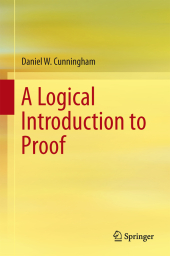 Neuerscheinungen 2014Stand: 2020-02-01 |
Schnellsuche
ISBN/Stichwort/Autor
|
Herderstraße 10
10625 Berlin
Tel.: 030 315 714 16
Fax 030 315 714 14
info@buchspektrum.de |

Daniel W. Cunningham
A Logical Introduction to Proof
2013. 2014. xvi, 356 S. 5 Tabellen. 235 mm
Verlag/Jahr: SPRINGER, BERLIN; SPRINGER NEW YORK; SPRINGER 2014
ISBN: 1-489-99099-2 (1489990992)
Neue ISBN: 978-1-489-99099-0 (9781489990990)
Preis und Lieferzeit: Bitte klicken
This unique textbook uses a ´logic-first´ approach to train and guide undergraduates through transition courses bridging calculus and advanced mathematics. It also offers a valuable introduction to group theory and real analysis, including proof strategies.
The book is intended for students who want to learn how to prove theorems and be better prepared for the rigors required in more advance mathematics. One of the key components in this textbook is the development of a methodology to lay bare the structure underpinning the construction of a proof, much as diagramming a sentence lays bare its grammatical structure. Diagramming a proof is a way of presenting the relationships between the various parts of a proof. A proof diagram provides a tool for showing students how to write correct mathematical proofs.
Preface.- The Greek Alphabet.- 1. Propositional Logic.- 2. Predicate Logic.- 3. Proof Strategies and Diagrams.- 4. Mathematical Induction.- 5. Set Theory.- 6. Functions.- 7. Relations.- 8. Core Concepts in Abstract Algebra.- 9. Core Concepts in Real Analysis.- A Summary of Strategies.- References.- List of Symbols. Index.
From the reviews:
"Cunningham (Buffalo State, SUNY) focuses on the strategies for different proof techniques. ... The well-written text is consistent in its focus, which should help students. The book includes sufficient, appropriate exercises. ... contains ample notes to guide students through most of the exercises. Whether used for a course or as a reference for students learning proof techniques, this book is certainly worthy of consideration. Summing Up: Highly recommended. Lower-division undergraduates through graduate students." (J. R. Burke, Choice, Vol. 51 (1), September, 2013)


